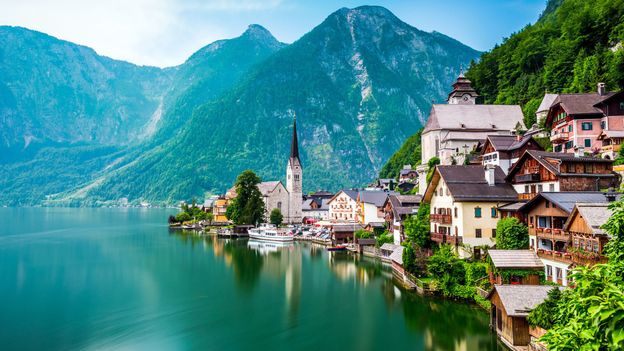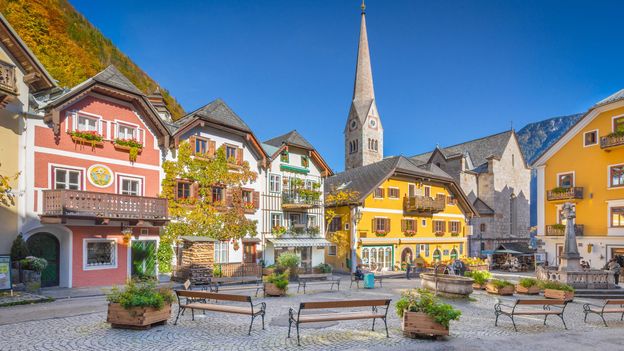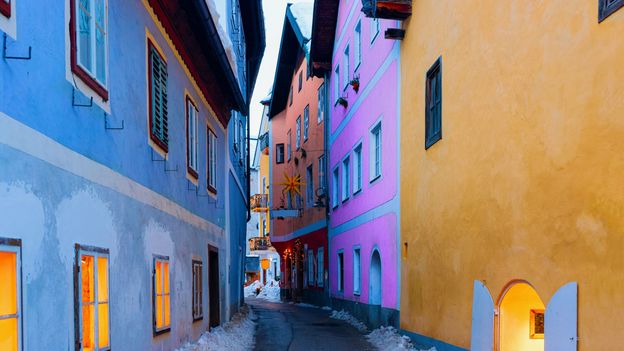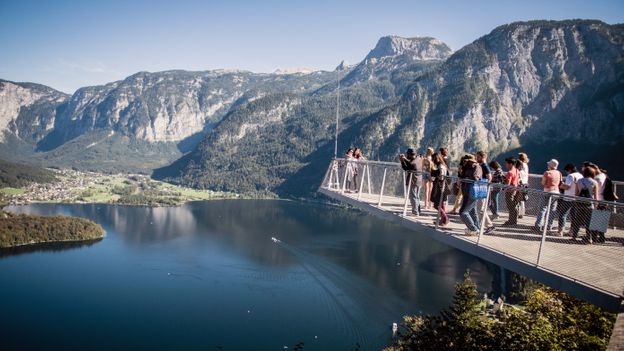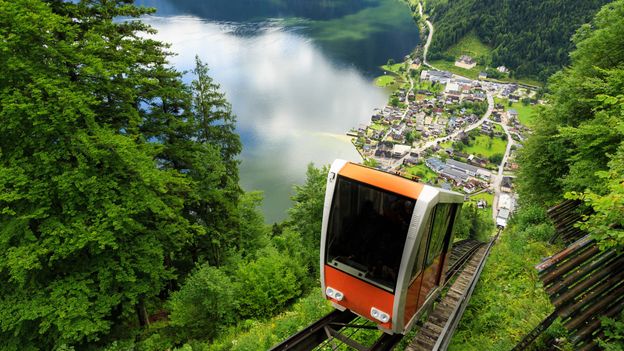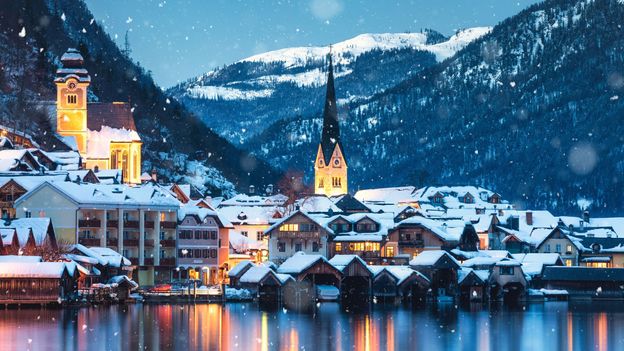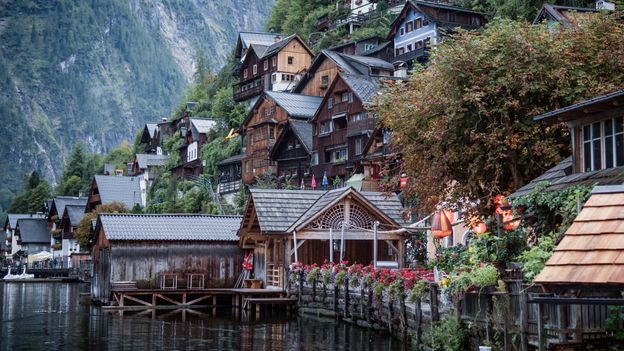Mục lục
Austria’s tiny village with 10,000 day-trippers
Usually Hallstatt would open its doors to almost 10,000 visitors a day. But amid Covid-19, everything has changed for the near-800 locals who call this charming Austrian village home.
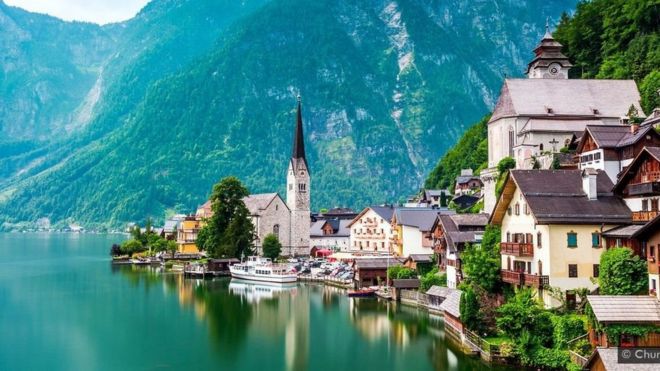
Selena Taylor makes her living road-tripping across continents and flying to disparate locations, but each place she visits must have a certain aesthetic.
As a travel blogger and photographer, Taylor hunts out the world’s most charming destinations and shares her exploits with her 175,000 Instagram followers.
“Knowing your audience is key,” said Taylor on what makes a post popular.
The fairy-tale village of Hallstatt is one of the most Instagrammed places on Earth (Credit: Svetikd/Getty Images)
In February 2020, Taylor visited the village of Hallstatt, located in Austria’s Salzkammergut region, that’s beloved by Instagrammers and influencers for its scenic beauty.
She was drawn to the “charming homes and cafes, beautiful backdrops and prime location on the water,” she said. “Hallstatt has grown popular in recent years and it checks a lot of boxes that make it appealing.”
Taylor spent several days wandering the streets of this fairy-tale village, drinking coffee amongst the mountain landscape and watching the sun set across the lake.
But a month after Taylor ticked Hallstatt off her bucket list, this tiny village went from one of the most Instagrammed places on Earth, according to Harper’s Bazaar, to experiencing something it hasn’t for years.
Hallstatt is located in Austria’s mountainous Salzkammergut region which is renowned for its scenic beauty (Credit: Chunyip Wong/Getty Images)
Silence.
At this time of year, the village of near 800 people would ordinarily open its doors to almost 10,000 daily visitors. The sound of reversing coaches and conversation in countless languages would fill the air, and the sky would be illuminated by flashes from digital cameras.
On 16 March, though, lockdown was implemented across Austria, changing everything for the locals who call Hallstatt home.
“It was like living in a ghost village,” said Hallstatt resident Sonja Katharina. “The world had stopped turning. It was frightening, quiet and calm. There were no cars, no buses and no tourists. We could even hear the swans swimming.”
As the initial shock made way for the warmer spring months, Katharina has been enjoying the benefits of solitude. She can drive through the streets without risk of oncoming pedestrians and spends her days cycling the Seestraße, or “Lake Street”, Hallstatt’s most photographed road that would usually be packed with around 4,000 tourists per day.
“The positives were that we had time to speak to each other – from a distance of course,” Katharina laughed. “We don’t have to hurry, and you learn to think about what is really important in life.”
The village’s 16th-Century architecture and cobblestone streets drew up to 10,000 daily visitors before Covid-19 hit (Credit: Bluejayphoto/Getty Images)
Like Katharina, others are cherishing the change in pace. “The drop in tourism happened more or less completely unexpectedly,” said local musician Gerhard Hallstatt. “All of a sudden, Hallstatt has gone back to its roots.”
A decade ago, the village received around 100 visitors a day. Now, pre-Covid-19, reports more than 1 million overnight stays per year.
In the summer months, many travel from across Asia, the US and UK; while in autumn and winter, tourists from nearby countries like Poland, Hungary, Germany and Czech Republic are enticed by the many mountain biking, climbing and hiking trails open at points throughout the year.
Why is Hallstatt so popular?
Some reasons are easily explained. Hallstatt and the surrounding region was awarded in 1997 for its magnificent Alpine landscape and ancient salt mining tradition. Its salt mine – one of the world’s oldest – welcomed 19,700 visitors from January until 15 March this year, all keen to learn the history of these 7,000-year-old tunnels or stare out at the mesmerising views of the salt lake.
Hallstatt is so popular with Chinese tourists that a life-size replica of the village has been constructed in Guangdong (Credit: RomanBabakin/Getty Images)
Since lockdown hit, it’s been zero. And while locals may be reconnecting with their roots, this also brings uncertainty.
“Hallstatt has always been a tourist hot spot, so a lot of people have lost their work or have reduced working hours,” said Kurt Reiger, CEO of the Hallstatt salt mine. “It doesn’t feel like having an old town back because our old town was always filled with tourists, a situation we love.”
Other reasons for Hallstatt’s allure are more unexpected. In 2006, episodes of the popular South Korean soap opera Spring Waltz were filmed in and around Hallstatt, which introduced the village to millions in Asia.
And Chinese tourists flock here too, partly thanks to the Chinese mining company Minmetals, which in 2012 unveiled a life-size replica of Hallstatt in the Chinese province of Guangdong. Since then, tourists have travelled thousands of miles to experience the real thing. The build reportedly cost more than 6.5bn yuan (£738m) and acts as a high-end property development for the wealthy, rather than the “pearl of Austria” as the original is known.
In January, Hallstatt’s tourism chiefs took steps to limit tourist buses to 50 per day (Credit: Edwin Husic)
Travellers also descend on Hallstatt thanks to the hugely popular animated film Frozen. Many people believe that Hallstatt’s spires and frosted mountaintops are the inspiration behind much of Frozen’s fictional fantasy land, the kingdom of Arendelle. There is just one problem to this claim. It isn’t true.
“When it comes to Frozen, that’s just rumours,” said Gregor Gritzky, CEO of the local tourist board Dachstein Salzkammergut. “We’ve had international press ask about it, but it’s all rumour.” In reality, the true inspiration behind Frozen is found in several locations across Norway, from Oslo’s Akershus Fortress to the old merchant quarter of Bryggen, Bergen.
What can be accurately believed, however, is that the village’s reputation as Austria’s most beautiful location has perhaps made Hallstatt too Instagram-friendly. Searching #Hallstatt on Instagram brings up more than 600,000 perfectly framed holiday snaps from tourists in choreographed poses.
Salzwelten, Hallstatt’s Unesco-recognised salt mines, can be accessed from the village by cable car (Credit: Gökçen TUNÇ/Getty Images)
“Tourism has two sides of the coin. There have been challenges with the number of guests, but it’s good for the municipality to have tourists,” Gritzky said. “We want people to do more than just take a picture, not get off the bus and go to the next place.”
While bringing obvious financial benefits, this level of tourism, has come with side effects. Some locals have complained of tourists turning up unannounced in their gardens, and drones are a common grievance.
In January, Hallstatt’s tourism chiefs took steps to limit tourist buses to 50 per day.
But, while more recent travel restrictions due to Covid-19 have given locals some well-deserved rest, many residents are beginning to miss the visitors.
Many people believe that Hallstatt’s spires and frosted mountaintops are the inspiration behind the kingdom of Arendelle in Frozen (Credit: Borchee/Getty Images)
“It’s a beautiful feeling to have some empty lanes for ‘ourselves’, but the people of Hallstatt are glad to share the beauty of the village with friends and guests from all over the world,” Gerhard Hallstatt said. “The villagers – like all those who live in touristy areas – have a certain love-hate relationship to tourism, but a huge amount of the population depends on it.”
There is good news for the village’s recovery, as local tourists are beginning to return as lockdown measures ease across Austria.
In mid-May, Simon König and his partner, who live around an hour’s drive from Hallstatt, took the golden opportunity to “visit this beautiful place without the mass tourism”.
“It’s never been so beautiful,” König remembered. “When we arrived, there were literally no people around except the locals working on their properties. Around midday, some people came from the surrounding communities for the same reason we did.”
As lockdown measures ease across Austria, local tourists are beginning to return to Hallstatt (Credit: Edwin Husic)
In Hallstatt, some hotels have just reopened, and so too have the famous salt mines. There are still more challenges to come: “I think tourism will take time [to return], but one of the biggest questions is who will be able to come and in what timespan?” said Gritzky.
But for Taylor, Hallstatt hasn’t lost what makes it special, even if it remains off limits “Hallstatt is particularly unique,” she said. “It is one of the few ‘trendy’ destinations that really exceeds expectations in person.”
Join more than three million BBC Travel fans by liking us on Facebook, or follow us on Twitter and Instagram.
Ngôi làng đẹp nhất nước Áo hóa ‘làng ma’ vì Covid-19
 GETTY IMAGES
GETTY IMAGESSelena Taylor kiếm sống bằng lái xe đi xuyên lục địa và bay đến các địa điểm khác nhau, nhưng mỗi nơi cô đến đều phải có tính thẩm mỹ nhất định.
Là một blogger và nhiếp ảnh gia du lịch, Taylor săn lùng những điểm đến quyến rũ nhất thế giới và chia sẻ những thành tích của cô với 175.000 người theo dõi trên Instagram.
“Điều then chốt là hiểu về khán giả của bạn,” Taylor nói về những điều làm sức hấp dẫn cho bài đăng trên mạng xã hội.
 GETTY IMAGES Làng Hallstatt đẹp như trong truyện cổ tích là một trong những địa điểm trên thế giới được đăng trên Instagram nhiều nhất
GETTY IMAGES Làng Hallstatt đẹp như trong truyện cổ tích là một trong những địa điểm trên thế giới được đăng trên Instagram nhiều nhất
Ngôi làng ma?
Vào tháng 2/2020, Taylor đến thăm làng Hallstatt, tọa lạc ở vùng Salzkammergut của Áo, vốn được cộng đồng người dùng và người có ảnh hưởng trên Instagram yêu thích vì phong cảnh đẹp của nó.
Cô đã bị thu hút bởi ‘những ngôi nhà và những quán cà phê quyến rũ, bối cảnh đẹp và vị trí đắc địa trên mặt nước’, cô nói. “Hallstatt đã trở nên rất được yêu thích trong những năm gần đây và nó đáp ứng nhiều tiêu chuẩn khiến nó trở nên hấp dẫn.”
Taylor đã dành vài ngày lang thang trên các đường phố của ngôi làng cổ tích này, uống cà phê giữa phong cảnh núi non và ngắm mặt trời lặn trên mặt hồ.
Nhưng một tháng sau khi Taylor đến được địa điểm thuộc danh sách nhất định phải đến một lần trong đời, ngôi làng nhỏ bé này đã đi từ một trong những nơi được lên Instagram nhiều nhất, theo tạp chí Harper’s Bazaar, đến trải nghiệm điều mà nó không hề biết trong nhiều năm.
 GETTY IMAGES
GETTY IMAGES
Bình thường thì vào thời điểm này trong năm, ngôi làng với gần 800 dân thường sẽ mở cửa cho gần 10.000 khách đến thăm hàng ngày.
Trong không trung đầy âm thanh của những chiếc xe khách đi lùi và những cuộc trò chuyện bằng vô số ngôn ngữ và bầu trời lấp lánh với những ánh đèn flash từ những máy ảnh kỹ thuật số.
Tuy nhiên, vào ngày 16/3, lệnh phong tỏa được áp dụng trên khắp nước Áo đã thay đổi mọi thứ đối với người dân Hallstatt.
“Giống như sống trong ngôi làng ma,” Sonja Katharina, cư dân Hallstatt nói. “Thế giới đã ngừng quay. Thật đáng sợ, yên ắng và tĩnh lặng. Không có xe hơi, không có xe buýt và không có du khách. Chúng tôi thậm chí có thể nghe thấy tiếng thiên nga đang bơi.”
Khi cú sốc ban đầu dọn đường cho những tháng mùa xuân ấm áp, Katharina đã tận hưởng những lợi ích của sự cô độc. Cô có thể lái xe qua các con phố mà không đối mặt với rủi ro gặp phải khách bộ hành đang bước tới và dành nhiều ngày để đạp xe trên đường Seestraße, hay ‘Đường Hồ’, con đường được chụp ảnh nhiều nhất của làng Hallstatt vốn thường tấp nập với khoảng 4.000 du khách mỗi ngày.
Sức hút của Hallstatt
“Điều tích cực là chúng tôi có thời gian nói chuyện với nhau – dĩ nhiên là giữ khoảng cách,” Katharina cười nói. “Chúng tôi không cần phải vội vàng, và học cách suy nghĩ về những gì thực sự quan trọng trong cuộc sống.”
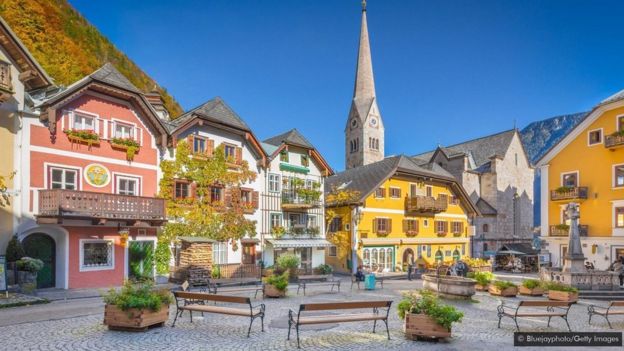 GETTY IMAGES Những kiến trúc có từ thời Thế kỷ 16 và những con phố lát sỏi của ngôi làng hấp dẫn tới 10 ngàn du khách tới thăm mỗi ngày trước khi Covid-19 ập đến
GETTY IMAGES Những kiến trúc có từ thời Thế kỷ 16 và những con phố lát sỏi của ngôi làng hấp dẫn tới 10 ngàn du khách tới thăm mỗi ngày trước khi Covid-19 ập đến
Giống như Katharina, những người khác cũng đang tận hưởng sự thay đổi nhịp độ. “Sự sụt giảm du khách xảy ra ít nhiều theo cách hoàn toàn bất ngờ,” Gerhard Hallstatt, nhạc sĩ địa phương, nói. “Đột nhiên, Hallstatt đã quay trở lại cội rễ của mình.”
Một thập niên trước, ngôi làng này đón khoảng 100 du khách mỗi ngày. Giờ đây, trước khi có đại dịch Covid-19, nó đón hơn 1 triệu lượt khách qua đêm mỗi năm.
Trong những tháng mùa hè, nhiều du khách đến từ khắp châu Á, Mỹ và Anh; trong khi vào mùa thu và mùa đông, điều lôi cuốn khách du lịch từ các nước lân cận như Ba Lan, Hungary, Đức và Cộng hòa Séc là những cung đường lội bộ, đường đạp xe đèo núi, đường leo núi vốn mở cửa tại những thời điểm trong suốt cả năm.
Làm sao làng Hallstatt thu hút du khách đến vậy?
Một số lý do rất dễ giải thích. Hallstatt và khu vực xung quanh hồi năm 1997 đã được tuyên dương với phong cảnh núi tuyết hùng vĩ và ngành khai mỏ muối có từ lâu đời. Mỏ muối ở đây – nằm trong số lâu đời nhất thế giới – đã đón 19.700 du khách từ tháng 1 đến ngày 15/3 năm nay, tất cả họ đều háo hức muốn tìm hiểu lịch sử của những đường hầm 7.000 năm tuổi hoặc ngắm khung cảnh hồ muối đẹp mê hồn.
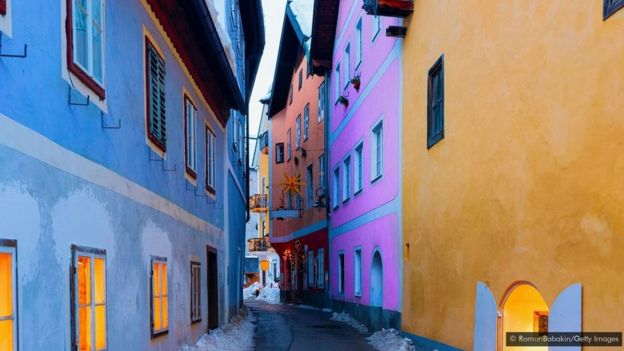 GETTY IMAGES Hallstatt nổi tiếng với du khách Trung Quốc đến nỗi một ngôi làng y hệt thế đã được xây dựng ở tỉnh Quảng Đông
GETTY IMAGES Hallstatt nổi tiếng với du khách Trung Quốc đến nỗi một ngôi làng y hệt thế đã được xây dựng ở tỉnh Quảng Đông
Kể từ khi phong tỏa xảy ra, tất cả chỉ còn là con số không. Và trong khi dân địa phương có thể tìm lại về cội rễ của họ, lệnh phong tỏa cũng đem lại sự bất định.
“Hallstatt luôn là điểm nóng du lịch, do đó rất nhiều người đã mất việc hoặc bị giảm giờ làm,” ông Kurt Reiger, CEO của mỏ muối Hallstatt, nói. “Không có cảm giác phố cổ trở lại như xưa bởi vì phố cổ của chúng tôi luôn chật kín du khách, điều mà chúng tôi yêu thích.”
Những lý do khác làm nên sức hấp dẫn của Hallstatt còn bất ngờ hơn. Hồi năm 2006, các tập phim Hàn Quốc Spring Waltz (Điệu Valse Mùa xuân) nổi tiếng đã được quay bên trong và xung quanh Hallstatt, giúp giới thiệu ngôi làng với hàng triệu người ở châu Á.
Và khách du lịch Trung Quốc cũng đổ về đây, một phần nhờ vào công ty khai mỏ Trung Quốc Minmetals, vốn vào năm 2012 đã cho ra mắt một bản sao làng Hallstatt với kích thước thật ở tỉnh Quảng Đông, Trung Quốc. Kể từ đó, các du khách đã đi hàng ngàn dặm để trải nghiệm ngôi làng thật. Công trình này được cho là tiêu tốn hơn 6,5 tỷ nhân dân tệ và hoạt động như một dự án xây dựng bất động sản cao cấp dành cho người giàu, thay vì là ‘hòn ngọc nước Áo’ vốn là danh xưng của ngôi làng phiên bản gốc.
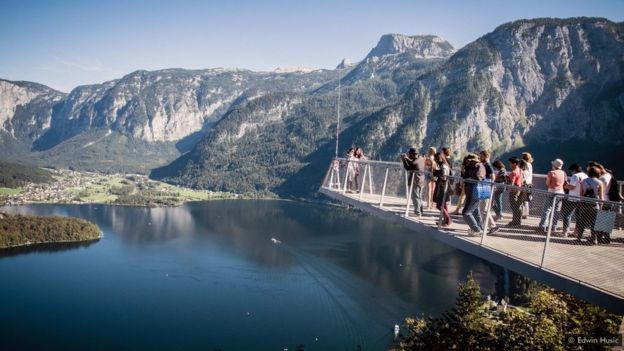 EDWIN HUSIC Hồi tháng Giêng, các quan chức du lịch ở Hallstatt đã phải ra lệnh hạn chế, chỉ cho tối đa 50 chiếc xe buýt đến làng mỗi ngày
EDWIN HUSIC Hồi tháng Giêng, các quan chức du lịch ở Hallstatt đã phải ra lệnh hạn chế, chỉ cho tối đa 50 chiếc xe buýt đến làng mỗi ngàyDu khách cũng đổ bộ đến Hallstatt nhờ vào phim hoạt hình cực kỳ được ưa chuộng, Frozen. Nhiều người tin rằng ngọn tháp và đỉnh núi băng giá của Hallstatt chính là nguồn cảm hứng cho hầu hết Vùng đất giả tưởng trong Frozen, vương quốc Arendelle. Giả thiết này chỉ có một vấn đề: nó không đúng.
“Khi nói đến Frozen, đó chỉ là tin đồn,” ông Gregor Gritzky, CEO của hội đồng du lịch địa phương Dachstein Salzkammergut, nói. “Báo chí quốc tế đã hỏi chúng tôi về điều này, nhưng tất cả chỉ là tin đồn.” Trên thực tế, nguồn cảm hứng thực sự đằng sau Frozen là ở một số địa điểm trên khắp Na Uy, từ Pháo đài Akershus ở thành phố Oslo đến khu phố buôn bán xưa Bryggen, Bergen.
‘Nhớ du khách’
Tuy nhiên, một niềm tin có thể chính xác là danh tiếng ngôi làng là địa điểm đẹp nhất nước Áo có lẽ đã khiến Hallstatt thân thiện với Instagram. Tìm kiếm #Hallstatt trên Instagram đem lại kết quả hơn 600.000 tấm ảnh chụp của du khách được lấy khung hình hoàn hảo trong các tư thế làm kiểu có đạo diễn.
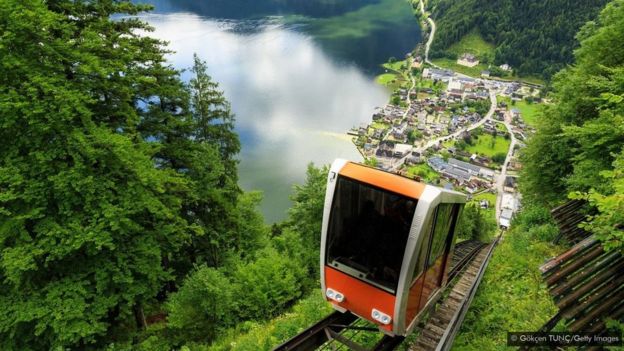 GETTY IMAGES Salzwelten, mỏ muối ở Hallstatt đã được Unesco công nhận, là nơi bạn có thể đi từ làng tới bằng cáp treo
GETTY IMAGES Salzwelten, mỏ muối ở Hallstatt đã được Unesco công nhận, là nơi bạn có thể đi từ làng tới bằng cáp treo“Du lịch có hai mặt cũng như hai mặt của đồng tiền. Đã có những thách thức với con số du khách, nhưng có khách du lịch là điều tốt cho địa phương,” Gritzky nói. “Chúng tôi muốn mọi người làm nhiều hơn là chỉ chụp ảnh, không xuống xe và đến địa điểm tiếp theo.”
Mặc dù mang lại lợi ích rõ ràng về tiền bạc, du lịch ở quy mô này cũng đưa đến các tác dụng phụ.
Một số người dân địa phương đã phàn nàn về việc khách du lịch xuất hiện không báo trước trong khu vườn của họ, và các thiết bị bay không người lái hoạt động vè vè là một vấn đề thường gây bức bối.
Vào tháng 1, các lãnh đạo du lịch ở Hallstatt đã có các bước đi giới hạn xe buýt du lịch xuống còn 50 chiếc mỗi ngày.
Tuy nhiên, mặc dù những hạn chế du lịch mới đây do dịch Covid-19 đã mang lại cho người dân địa phương chút nghỉ ngơi mà họ đáng được có, nhiều người bắt đầu nhớ du khách.
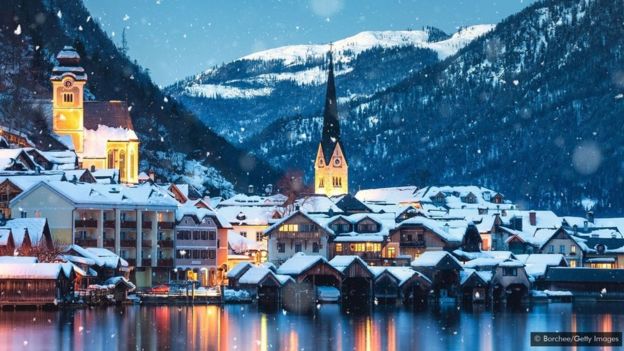 GETTY IMAGES Nhiều người tin rằng những ngôi nhà mái nhọn nằm trên những triền núi phủ tuyết của Hallstatt đã tạo cảm hứng cho sự ra đời của vương quốc Arendelle trong phim Frozen
GETTY IMAGES Nhiều người tin rằng những ngôi nhà mái nhọn nằm trên những triền núi phủ tuyết của Hallstatt đã tạo cảm hứng cho sự ra đời của vương quốc Arendelle trong phim Frozen
“Thật là một cảm giác đẹp khi có một số làn đường trống cho ‘chính mình’, nhưng người dân Hallstatt rất vui được chia sẻ vẻ đẹp của ngôi làng với bạn bè và du khách từ khắp nơi trên thế giới,” Gerhard Hallstatt nói. “Dân làng – giống như tất cả những ai sống ở khu vực du lịch – có mối quan hệ yêu-ghét nhất định với du lịch, nhưng phần lớn người dân phụ thuộc vào nó.”
Có tin tốt cho sự phục hồi của làng, vì du khách địa phương đang bắt đầu quay trở lại khi các biện pháp phong tỏa được nới lỏng trên khắp nước Áo.
Vào giữa tháng Năm, Simon König và bạn đời của ông, vốn sống cách Hallstatt khoảng một giờ lái xe, đã tận dụng cơ hội vàng để ‘đến thăm nơi xinh đẹp này mà không gặp đông đảo du khách’.
“Nó chưa bao giờ đẹp đến thế,” König nhớ lại. “Khi chúng tôi đến, thực sự không có ai xung quanh ngoại trừ dân địa phương đang làm việc trong nhà của họ. Khoảng giữa trưa, có một số người từ các cộng đồng xung quanh đến với lý do cũng giống như của chúng tôi.”
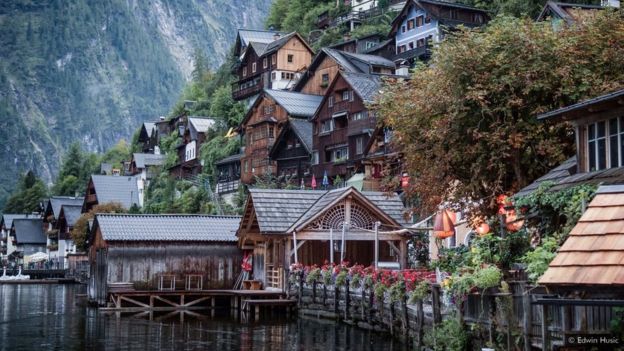 EDWIN HUSIC Do các biện pháp phong tỏa đã được nới lỏng trên toàn nước Áo, du khách địa phương đang bắt đầu trở lại Hallstatt
EDWIN HUSIC Do các biện pháp phong tỏa đã được nới lỏng trên toàn nước Áo, du khách địa phương đang bắt đầu trở lại HallstattỞ Hallstatt, một số khách sạn vừa mới mở cửa trở lại, và những mỏ muối nổi tiếng cũng vậy. Vẫn còn nhiều thách thức sắp tới. “Tôi nghĩ sẽ mất thời gian để du lịch khôi phục trở lại, nhưng một trong những câu hỏi lớn nhất là ai có thể đến và trong khoảng khung thời gian nào?” Gritzky nói.
Nhưng đối với Taylor, Hallstatt đã không đánh mất điều khiến nó trở nên đặc biệt, ngay cả khi nó vẫn còn không thể đến được.
“Hallstatt đặc biệt độc đáo,” cô nói. “Đó là một trong số ít những điểm đến thời thượng mà thực sự vượt quá mong đợi khi đến thăm trực tiếp.”


